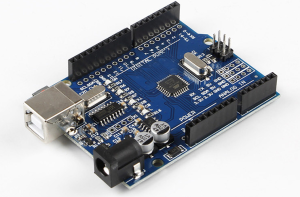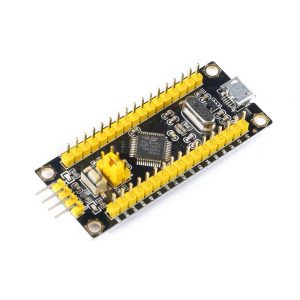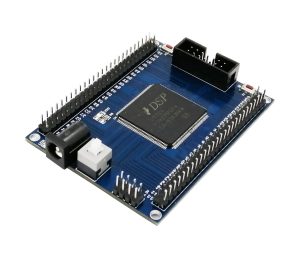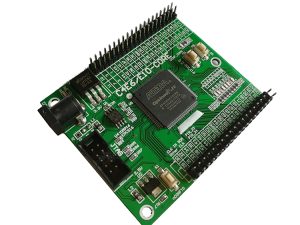“Empower Innovation: Unleash Your Potential with Development Boards”
Úvod
Development boards offer numerous advantages for both novice and experienced developers. They provide a cost-effective and accessible platform for prototyping and testing electronic circuits and software applications. These boards come equipped with essential components such as microcontrollers, input/output interfaces, and connectivity options, which streamline the development process. Additionally, development boards often include extensive documentation, community support, and pre-built libraries, making it easier to learn and implement complex functionalities. Their modular design allows for easy integration with various sensors and peripherals, fostering innovation and accelerating the development cycle. Overall, development boards are invaluable tools that enhance learning, experimentation, and the rapid creation of functional prototypes.

Accelerated Prototyping
Development boards have become indispensable tools in the realm of electronics and embedded systems, offering a myriad of advantages that significantly accelerate the prototyping process. These versatile platforms provide a pre-assembled circuit with a microcontroller or microprocessor, along with essential peripherals, which allows engineers and hobbyists to focus on innovation rather than the intricacies of circuit design. Consequently, the time required to move from concept to functional prototype is drastically reduced.
One of the primary benefits of development boards is their ability to simplify the hardware design phase. Traditional prototyping often involves designing custom printed circuit boards (PCBs), which can be both time-consuming and costly. Development boards, however, come pre-equipped with essential components such as voltage regulators, oscillators, and communication interfaces. This pre-integration means that users can bypass the initial stages of hardware assembly and testing, thereby expediting the development cycle.
Moreover, development boards are typically accompanied by extensive documentation and community support. Manufacturers provide detailed datasheets, application notes, and reference designs, which serve as invaluable resources for developers. Additionally, the active communities surrounding popular development boards, such as Arduino, Raspberry Pi, and ESP8266, offer forums, tutorials, and shared projects. This collective knowledge base enables rapid troubleshooting and fosters collaborative innovation, further accelerating the prototyping process.
Another significant advantage is the ease of software development facilitated by development boards. These platforms often support a variety of programming environments and languages, ranging from low-level assembly to high-level scripting languages. Integrated development environments (IDEs) tailored for specific boards streamline the coding process by offering features such as code auto-completion, debugging tools, and pre-built libraries. These libraries abstract complex functionalities into simple function calls, allowing developers to implement sophisticated features without delving into the underlying code. As a result, software development becomes more efficient, and the time to achieve a working prototype is minimized.
In addition to hardware and software simplification, development boards offer unparalleled flexibility and scalability. Many boards are designed with modularity in mind, featuring pin headers and expansion slots that allow for easy integration of additional components and sensors. This modular approach enables developers to iteratively enhance their prototypes, testing new ideas and functionalities without the need for extensive redesigns. Furthermore, the scalability of development boards ensures that prototypes can be easily transitioned to production-ready designs by leveraging compatible, production-grade modules.
The cost-effectiveness of development boards also plays a crucial role in accelerating prototyping. These boards are mass-produced, which significantly reduces their cost compared to custom-built solutions. This affordability allows for multiple iterations and experimentation without incurring prohibitive expenses. Additionally, the availability of open-source hardware designs means that developers can modify and tailor the boards to their specific needs, further optimizing the prototyping process.
In conclusion, development boards offer a multitude of advantages that collectively accelerate the prototyping process. By simplifying hardware design, facilitating software development, providing extensive documentation and community support, and offering flexibility and cost-effectiveness, these platforms empower developers to rapidly transform their ideas into functional prototypes. As technology continues to evolve, the role of development boards in fostering innovation and expediting product development is likely to become even more pronounced.
Cost-Effective Learning
Development boards have become an indispensable tool in the realm of electronics and computer science, offering a cost-effective means for both novices and professionals to learn, experiment, and innovate. These compact, versatile platforms provide a practical and economical way to explore complex concepts without the need for extensive resources or advanced equipment. One of the primary advantages of development boards is their affordability, which democratizes access to technology and fosters a more inclusive learning environment.
To begin with, development boards such as Arduino, Raspberry Pi, and ESP8266 are relatively inexpensive compared to traditional laboratory equipment. This affordability allows educational institutions to equip their classrooms and laboratories with multiple units, thereby enabling hands-on learning for a larger number of students. Consequently, learners can engage in practical experiments and projects that reinforce theoretical knowledge, bridging the gap between abstract concepts and real-world applications. This experiential learning approach not only enhances comprehension but also stimulates creativity and problem-solving skills.

Moreover, the cost-effectiveness of development boards extends beyond the initial purchase price. These platforms often come with a plethora of free or low-cost resources, including online tutorials, community forums, and open-source software. These resources provide invaluable support for learners, allowing them to troubleshoot issues, share ideas, and collaborate on projects. The availability of such extensive support networks reduces the need for expensive textbooks or specialized training, further lowering the overall cost of education and making it more accessible to a diverse audience.
In addition to their affordability, development boards are designed to be user-friendly, which significantly reduces the learning curve for beginners. The simplicity of their design, coupled with intuitive programming environments, allows learners to quickly grasp fundamental concepts and start building projects with minimal prior knowledge. This ease of use encourages experimentation and iterative learning, where students can learn from their mistakes and progressively refine their skills. As a result, development boards serve as an excellent entry point for individuals who are new to electronics and programming, providing a solid foundation upon which they can build more advanced knowledge.
Furthermore, the modular nature of development boards enhances their cost-effectiveness by allowing users to expand their capabilities incrementally. Instead of investing in a wide array of specialized equipment, learners can start with a basic board and gradually add peripherals and sensors as needed. This modular approach not only reduces initial costs but also allows for targeted investments based on specific project requirements. Consequently, learners can tailor their learning experience to their interests and goals, maximizing the educational value of their investment.
Another significant advantage of development boards is their reusability. Unlike single-use kits or consumable materials, development boards can be repurposed for multiple projects, making them a sustainable and economical choice for long-term learning. This reusability is particularly beneficial in educational settings, where budgets are often constrained, and resources must be utilized efficiently. By enabling repeated use, development boards ensure that learners can continue to explore new concepts and technologies without incurring additional costs.
In conclusion, the cost-effective nature of development boards makes them an invaluable resource for learning and experimentation in the fields of electronics and computer science. Their affordability, coupled with extensive support resources, user-friendly design, modularity, and reusability, provides a comprehensive and economical solution for both beginners and experienced practitioners. By lowering the financial barriers to entry, development boards democratize access to technology and empower a broader audience to engage in innovative and meaningful learning experiences.
Versatile Connectivity Options
Development boards have become indispensable tools in the realm of electronics and embedded systems, offering a plethora of advantages that cater to both novice hobbyists and seasoned engineers. One of the most significant benefits of these boards is their versatile connectivity options, which facilitate a wide range of applications and enhance the overall functionality of projects. This versatility is crucial in a world where the Internet of Things (IoT) and interconnected devices are becoming increasingly prevalent.
To begin with, development boards typically come equipped with a variety of input and output (I/O) pins, which allow for seamless integration with numerous sensors, actuators, and other peripheral devices. These I/O pins can be configured for digital or analog signals, providing flexibility in the types of components that can be connected. For instance, digital pins can be used to interface with simple on/off devices like LEDs or switches, while analog pins can read varying voltage levels from sensors such as temperature or light sensors. This adaptability is essential for creating complex systems that require multiple types of data inputs and outputs.
Moreover, many development boards feature built-in communication protocols, such as I2C, SPI, and UART, which enable efficient data exchange between the board and connected devices. These protocols are standardized, ensuring compatibility with a wide range of components and modules. For example, I2C allows for communication with multiple devices using just two wires, making it ideal for applications where space and wiring complexity are concerns. SPI, on the other hand, offers faster data transfer rates, which is beneficial for high-speed applications like data logging or real-time processing. UART provides a simple and reliable method for serial communication, often used for debugging or interfacing with serial devices like GPS modules.
In addition to these traditional communication methods, modern development boards often include wireless connectivity options such as Wi-Fi, Bluetooth, and even cellular capabilities. Wi-Fi-enabled boards can connect to local networks or the internet, allowing for remote monitoring and control of devices. This is particularly useful in IoT applications, where devices need to communicate with cloud services or other networked devices. Bluetooth connectivity offers a convenient way to interface with smartphones, tablets, or other Bluetooth-enabled devices, enabling user-friendly control and data exchange. Cellular connectivity extends the reach of development boards to areas without Wi-Fi coverage, making them suitable for remote or mobile applications.
Furthermore, the inclusion of USB ports on many development boards provides an additional layer of connectivity. USB ports can be used for programming the board, powering it, or connecting it to other USB devices such as keyboards, mice, or storage devices. This versatility simplifies the development process and expands the range of possible applications.
Another noteworthy aspect is the availability of expansion headers and shields, which are designed to extend the functionality of development boards. These add-ons can provide additional I/O pins, specialized communication interfaces, or even entirely new capabilities like GPS, GSM, or environmental sensing. The modular nature of these expansions allows developers to customize their boards to meet specific project requirements without the need for extensive redesigns.
In conclusion, the versatile connectivity options offered by development boards significantly enhance their utility and applicability across a wide range of projects. By providing multiple methods for interfacing with sensors, actuators, and other devices, as well as supporting various communication protocols and wireless technologies, these boards empower developers to create sophisticated and interconnected systems. This versatility not only simplifies the development process but also opens up new possibilities for innovation in the rapidly evolving field of electronics and embedded systems.
Extensive Community Support
Development boards have become indispensable tools in the realm of electronics and embedded systems, offering a plethora of advantages to both novice and experienced developers. One of the most significant benefits of using development boards is the extensive community support that accompanies them. This support network not only accelerates the learning curve but also fosters innovation and problem-solving.
To begin with, development boards such as Arduino, Raspberry Pi, and ESP8266 have garnered large, active communities over the years. These communities consist of hobbyists, educators, and professionals who contribute a wealth of knowledge and resources. For instance, online forums, social media groups, and dedicated websites provide platforms where users can ask questions, share projects, and offer solutions. This collective intelligence ensures that even the most obscure issues can often be resolved quickly, thereby reducing downtime and frustration.
Moreover, the availability of comprehensive documentation and tutorials is another facet of community support that cannot be overlooked. Official websites and user-generated content offer step-by-step guides, video tutorials, and detailed datasheets that cover a wide range of topics. Whether one is looking to blink an LED or build a complex IoT system, the chances are high that someone has already documented the process. This extensive repository of information makes it easier for beginners to get started and for experts to delve into more advanced projects.
In addition to documentation, open-source libraries and code repositories play a crucial role in simplifying development. Platforms like GitHub host thousands of projects and libraries that are freely available for use and modification. These resources can significantly cut down development time by providing pre-written code for common functionalities such as sensor interfacing, communication protocols, and data processing. Consequently, developers can focus more on innovation rather than reinventing the wheel.

Furthermore, community-driven events such as hackathons, workshops, and meetups provide invaluable opportunities for learning and networking. These events often feature hands-on sessions, expert talks, and collaborative projects that can enhance one’s skills and knowledge. Participating in such events not only broadens one’s understanding but also opens up avenues for collaboration and mentorship. The sense of camaraderie and shared purpose in these gatherings can be highly motivating and inspiring.
Another noteworthy aspect is the continuous improvement and updates driven by community feedback. Development boards and their associated software often receive regular updates that add new features, fix bugs, and improve performance. This iterative process is largely fueled by user feedback and contributions, ensuring that the tools remain relevant and up-to-date. For example, the Arduino IDE and Raspberry Pi OS frequently release updates that incorporate user suggestions and address common issues, thereby enhancing the overall user experience.
Additionally, the community support extends to hardware modifications and customizations. Enthusiasts often share their designs for custom shields, breakout boards, and enclosures that can extend the functionality of development boards. These designs are usually accompanied by detailed instructions and schematics, making it easier for others to replicate and build upon them. This collaborative approach accelerates innovation and allows for the rapid prototyping of new ideas.
In conclusion, the extensive community support surrounding development boards is a multifaceted advantage that significantly enhances their utility and appeal. From abundant documentation and open-source libraries to community events and continuous updates, the collective efforts of a global community make these tools more accessible, versatile, and powerful. This robust support network not only facilitates learning and problem-solving but also fosters a culture of collaboration and innovation, making development boards an invaluable asset in the field of electronics and embedded systems.

Simplified Debugging Process
Development boards have become indispensable tools in the realm of electronics and embedded systems, offering a myriad of advantages that streamline the design and implementation process. One of the most significant benefits they provide is the simplified debugging process, which is crucial for both novice and experienced developers. This article delves into the various aspects of how development boards facilitate easier debugging, thereby enhancing the overall efficiency and effectiveness of project development.
To begin with, development boards come equipped with a plethora of built-in features that are specifically designed to aid in debugging. These features often include integrated debugging interfaces such as JTAG or SWD, which allow developers to directly interact with the microcontroller or microprocessor. By providing real-time access to the internal state of the system, these interfaces enable the identification and rectification of issues at an early stage. Consequently, this reduces the time and effort required to troubleshoot complex problems, thereby accelerating the development cycle.
Moreover, development boards typically offer a range of diagnostic tools that further simplify the debugging process. For instance, many boards are equipped with status LEDs, which can be used to indicate the operational state of various components. These visual indicators provide immediate feedback, allowing developers to quickly ascertain whether a particular module is functioning correctly. Additionally, some boards include serial communication interfaces, such as UART, SPI, or I2C, which facilitate the monitoring of data flow between different parts of the system. By analyzing this data, developers can pinpoint the source of errors and implement corrective measures with greater precision.
Another key advantage of development boards is their compatibility with a wide array of software development environments. Integrated Development Environments (IDEs) such as Arduino IDE, MPLAB X, and Keil µVision offer comprehensive debugging tools that are specifically tailored for use with development boards. These IDEs provide features such as breakpoints, watch variables, and step-by-step execution, which allow developers to meticulously examine the behavior of their code. By leveraging these tools, developers can gain deeper insights into the functioning of their programs, thereby facilitating the identification and resolution of bugs.
Furthermore, development boards often come with extensive documentation and community support, which can be invaluable resources during the debugging process. Detailed datasheets, user manuals, and application notes provide critical information about the board’s architecture and functionality, enabling developers to better understand the intricacies of their system. Additionally, online forums and communities offer a platform for developers to share their experiences and seek assistance from peers. This collaborative environment fosters the exchange of knowledge and best practices, thereby enhancing the overall debugging experience.
In addition to these technical advantages, development boards also promote a more systematic approach to debugging. By providing a standardized platform for development, these boards encourage the use of modular design principles, which can significantly simplify the identification and isolation of issues. For example, developers can test individual modules independently before integrating them into the larger system, thereby ensuring that each component functions correctly. This modular approach not only streamlines the debugging process but also enhances the overall reliability and robustness of the final product.
In conclusion, development boards offer a multitude of features and tools that significantly simplify the debugging process. From integrated debugging interfaces and diagnostic tools to compatibility with advanced software development environments and extensive documentation, these boards provide a comprehensive solution for identifying and resolving issues. By leveraging these advantages, developers can enhance the efficiency and effectiveness of their projects, ultimately leading to the creation of more reliable and robust systems.

OTÁZKY A ODPOVĚDI
1. **What is a primary advantage of using development boards for prototyping?**
– Rapid prototyping and testing of ideas without the need for custom hardware design.
2. **How do development boards benefit learning and education?**
– They provide a hands-on platform for students and hobbyists to learn electronics and programming.
3. **What advantage do development boards offer in terms of community support?**
– Extensive community support and resources, including tutorials, forums, and libraries.
4. **Why are development boards considered cost-effective?**
– They reduce the need for expensive and time-consuming custom PCB design and manufacturing.
5. **How do development boards facilitate software development?**
– Pre-loaded bootloaders and integrated development environments (IDEs) simplify coding and debugging.
Závěr
Development boards offer numerous advantages, including ease of prototyping, cost-effectiveness, and accessibility for both beginners and professionals. They provide a versatile platform for testing and developing electronic projects, often featuring built-in components and interfaces that simplify the design process. Additionally, development boards are supported by extensive communities and resources, which facilitate learning and troubleshooting. Overall, they accelerate innovation and reduce the time and effort required to bring ideas to fruition.
